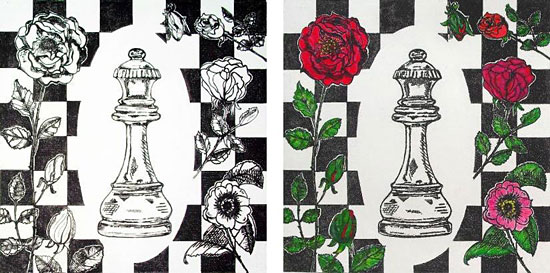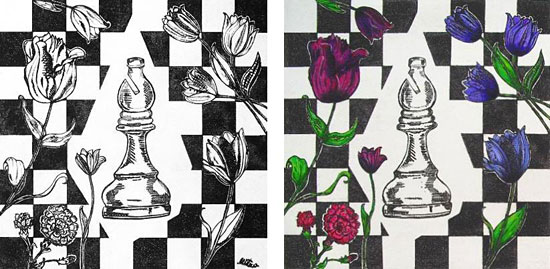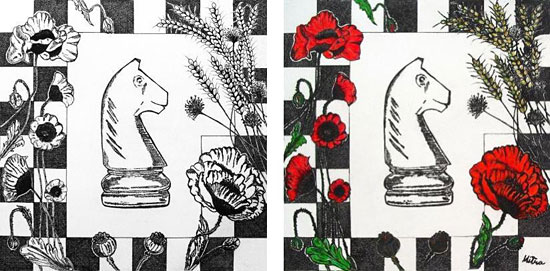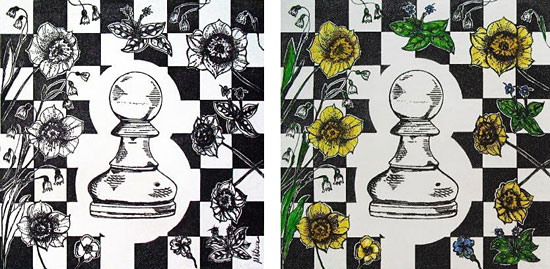


Winning starts with what you know
The new version 18 offers completely new possibilities for chess training and analysis: playing style analysis, search for strategic themes, access to 6 billion Lichess games, player preparation by matching Lichess games, download Chess.com games with built-in API, built-in cloud engine and much more.

Etching, as fine art printmaking, is among the oldest in the history of art. Together with engraving, drypoint, aquatint or mezzotint and collography, it is part of a family of printmaking techniques known as intaglio (from the Italian intagliare – to engrave). Its main component is a metal plate, usually copper or zinc, on which an image is incised with a sharp needle, thus producing a matrix. The printing process is long and arduous and requires considerable craft.
Ancient Eastern cultures like Japan and China brought the art of printing to the highest level of artistic achievement. Woodcut was their main technique, although engraving was also used. These techniques required only low pressure to print. Rubbing or simple and light weighted presses may have been used in order to bring into firm contact the inked block with a paper or cloth.
With the invention of the printing press, various fine art printing styles and variations were developed. Etching is one of them. Some of the greatest artists have adopted this technique to create an important part of their production, most notably Rembrandt, Dürer, Blake and Goya. Over time the etching press underwent some technical improvements, replacing the wood with sturdier, metal components and smoother rotating wheels, but basically, its shape and operation remain the same since antiquity.

Rembrandt’s etching press is preserved in the Rembrandt House Museum in Amsterdam
There are many printing variations and sub-variations, which combined and enhanced further with coloured inks or post-print hand-colouring can result in a rich, elaborate work on paper. I apply the most traditional, purest form of etching without any fancy deviations.
With nostalgia, I look back 25 years ago, when in Australia, then on a three-year lecturing contract, I learned and produced my first etching. It was thanks to my lucky meeting and friendship with a great artist and person, Memnuna Vila-Bogdanich (1934–2004), who instructed me privately in the art of etching and made available to me her printing studio in Perth, Australia. My first etching was of a very personal character, dedicated to the long-distance corresponding relationship with my mother.

My Mother’s Letter, 1989, Etching, limited edition of 12, 25 X 25 cm
My involvement with chess compelled me to revisit this technique, after a long break, and produce the six chess pieces, which together with my chess paintings complete the cycle of works on the theme of chess.
Every now and then, I find myself having to explain to friends, and particularly to chess-friends, the true nature and the artistic merit of a fine art print, so I will give a brief account for our larger audience here, as well.
Not many people are aware of the subtleties of the process in producing an etching. It is basically a printing technique by which multiple copies of an identical image is produced. This is usually a limited edition, the number of prints decided by the artist. The ‘multiple number’ of the same work diminishes its value compared to a unique work; hence, their selling price is considerably lower.
However, it must not be confused with the ‘mass printing’ associated with newspapers, posters, etc. The only similarity is the use of a machine – a printing press. While the industrial presses can produce millions of copies and pages in one run, the etching press can produce only one copy at a time. The whole process – inking, cleaning off the surplus of ink, preparing the paper, which must be damp to an appropriate level, passing it through the press, drying the paper, making corrections, applying final touches, hand colouring etc. – is painstakingly repeated for each print, individually. The production of a single print is long, strenuous and needs utter precision and patience. In effect, in terms of creation, each print is an ‘original’; the term 'multiple' here refers only to the repetition of one and the same ‘image’.

The plates just etched – the black parts are the etching ground,
the orangey parts are the copper etched with chess images.
A plate of zinc or copper is first covered with a layer of acid-resistant varnish or wax, called ‘ground’. The artist then scratches through the ground with an etching needle to expose the metal beneath. When the design is complete, the plate is dipped in acid, which eats away the lines where the metal has been exposed. The depth of the lines depends on the length of time the plate is exposed to the acid. When the ‘biting’ is finished, which does not last more than few minutes depending on the strength of the acid, the ground is washed off, the plate is dried and is ready to be inked.

The plate etched, the ground washed off, ready for a new inking
Etching ink is applied over the whole plate but with a particular attention to reach inside the incised lines. The surplus ink is wiped off with tarlatan or paper. A damp paper is placed on top of the inked side of the plate; it is covered with felt blankets and run under a printing press. Through pressure, the ink transfers from the recesses of the plate to the paper.

The paper with a printed image is hang to dry
The first few copies are trials, and are called ‘author proofs’. They serve to bring about the final, desired state of the image before proceeding to printing the whole edition. By the time the last number in the edition has been printed, the plate may ware off, but even if not, the artist is supposed to destroy it, so that the ‘limited’ edition is truly limited. This is not always followed, and on occasions, the market can be flooded with additional number of prints being created fraudulently, which causes difficulty for art dealers, historians and assessors to establish the originality and value of a print.
Etching inks today exist in many colours; however the black & white print has been traditionally accepted as a classical, elegant image. They may be hand-coloured afterwards in acrylics, oils, or any other painting mediums. My preference is black & white. I also sometimes like to use dark, brown-sienna inks to achieve an antique look. The colours can also be reversed by an alternative inking method where the ink is applied with a roller.

An 'antique' rook in reversed colours
However, a coloured version is widely appealing so the etchings of the chess pieces I made exist in both black & white and in (hand-applied) colour. I used some visual symbolism to design the background with geometric shapes and flower decorations corresponding to each chess piece.

The King sits in an altar-like space within a partially designed chessboard and is
surrounded with branches of ivy and laurel – symbols of victory [Enlarge: b/w – colour]

The Queen is vainly admiring herself in a mirror among roses [Enlarge: b/w – colour]

The Rook sits within a castle-tower encircled with marsh plants [Enlarge: b/w – colour]

The Bishop is under diagonal lines with tulips as decoration [Enlarge: b/w – colour]

The Knight is within an L shape in a field of poppies and cereals [Enlarge: b/w – colour]

The Pawn walks among spring flowers [Enlarge: b/w – colour]
The above etchings are 25 x 25 cm (the image) and 38 x 35 cm (framed). The edition of each etching is limited to 50, and the price is €450 for the Black & White or €550 for coloured, plus €50 if you want them framed – in acid-free, museum quality material to preserve the paper, which is fragile and prone to fading and flecking (‘foxing’).
This series of six etchings allow many ways of arrangements on the wall. They can be displayed individually or in small groups, positioned horizontally or vertically. Their sizes, when framed, can vary but the smallest would be around 46 x 43 cm.

An simple wall display of the six pieces, in basic, small-size frames
More inventive arrangements are also possible, like putting all pieces under one and the same frame, thus creating a large ‘painting’ in either vertical or horizontal position, black & white or coloured, where the chess pieces look like they are floating in an imaginary, exotic garden. It may reach an approximate size of 70 X 100 cm.
You might have noticed a slight anomaly regarding the Knight. My friend, Stewart Reuben (a well known international organiser and arbiter and keen on precision), upon viewing the images, commented in an email: ‘I am used to see the Knight looking in the opposite direction.’ Indeed, in the original drawing the Knight does look in the ‘right’ direction.

The Knight at an early stage, just etched with the ground still on
However, I had overlooked the ‘mirror effect’ that the image undergoes when printed. Ah, well, for the time being, nothing can be done and this little horsey will be turned in the ‘not usual’ direction.

Suze approves, so that's settled then
If you are interested in seeing more work of Diana Mihajlova or
purchasing any of her etchings you can do so on this page of the Mitra web site.
 Diana Mihajlova is a chess player and artist who has been exhibiting internationally (under the name Yana Mitra) since 1988. She was born in Macedonia (former Yugoslavia). A linguist by profession she started her working career as a university lecturer, which took her to extensive studying and working sojourns in various countries around the world. In 1989 after finishing a three-year lecturing contract in Perth, Australia, she decided to abandon her academic career and to dedicate herself to a full-time painting, while still free-lancing in the languages field. She first started exhibiting while still in Australia, where after winning some important national art prizes her work received a quick recognition and was included in important exhibitions and collections. After her return to Europe she continued her painting career by exhibiting in galleries in Paris, where she spent the following two years. Since 1993 she settled in London where she lives and works. You can see her paintings at the Yana Mitra web site.
Diana Mihajlova is a chess player and artist who has been exhibiting internationally (under the name Yana Mitra) since 1988. She was born in Macedonia (former Yugoslavia). A linguist by profession she started her working career as a university lecturer, which took her to extensive studying and working sojourns in various countries around the world. In 1989 after finishing a three-year lecturing contract in Perth, Australia, she decided to abandon her academic career and to dedicate herself to a full-time painting, while still free-lancing in the languages field. She first started exhibiting while still in Australia, where after winning some important national art prizes her work received a quick recognition and was included in important exhibitions and collections. After her return to Europe she continued her painting career by exhibiting in galleries in Paris, where she spent the following two years. Since 1993 she settled in London where she lives and works. You can see her paintings at the Yana Mitra web site.